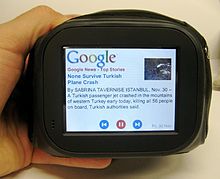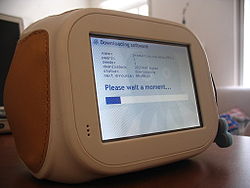- Chumby
-
The Chumby is a consumer electronics product made by Chumby Industries, Inc.. It is an embedded computer which provides Internet and LAN access via a Wi-Fi connection. Through this connection, the Chumby runs various software widgets.
Roughly resembling a small clock radio, it consists of a small touch-screen with a leather and plastic exterior. It uses AC power and turns off if unplugged; a 9 volt battery connector is supplied for backup power. It comes in six colors.
The Chumby was praised as open source hardware: it is designed to be customizable by users.[1] Wired magazine named Chumby one of its top gadgets for 2008.[2] Its software is mostly open source, running on Linux.
Contents
History
The Chumby premiered on August 25, 2006 at Foo Camp and was released to around 100 alpha release testers at the event.[3][4]
Shortly after Foo Camp, Chumby announced a free Chumby offer, where applicants would receive the same alpha-level Chumby as those previously given away. Applicants submitted ideas for software applications or hardware modifications. One of the goals for the free offer was to have Chumbys in the hands of developers who were willing to begin building applications.[5]
In July 2007, a First 50 was released to 50 random applicants, who received the next generation of Chumbys.[6] This was followed, in September, with an Insiders Release. Interested parties could send e-mail to Chumby requesting release information, and were given the opportunity to join in the Insiders Release.[7] Finally, in February 2008, the commercial release was made public on the Chumby Store.[8] In May 2008, the price was $179.95[9] for any one of three colors, latte, basic black, and pearl. In Japan, Chumby is available through Zyyx, Inc. as www.chumby.jp since October 23, 2008. In Australia, the Chumby is available through ISP Internode.
In November 2009 the Chumby One was released: a similar, all plastic version of the original, only available in white with a blue trim. The major difference was the hard plastic casing replacing the soft leather casement. Other changes include a slightly faster processor, only 1 USB port on the rear of the device, and inclusion of FM tuner and physical volume knob. The advantage of the plastic hard case allowed Chumby Industries to offer the Chumby One at a reduced price of $119.95.
Features
Hardware
The Chumby is designed as open source hardware, with schematics, PCB layouts and packaging/outerware designs available. Hardware specs are as follows[10]
The Original Chumby
- 350 MHz ARM9-based Freescale i.MX21 controller
- 64 MB of SDRAM
- 64 MB of NAND flash ROM
- 320×240 3.5 inch touchscreen TFT LCD running at 12 frames per second
- stereo 2 W speakers, an audio output, an integrated microphone
- two USB 2.0 ports
- integrated Wi-Fi
- a bend sensor for squeeze-based user interface features
- motion sensor (accelerometer).
The Chumby One
- 454 MHz ARM processor
- 64 MB DDR SDRAM
- 2 GB internal microSD card (some only have 1 GB)
- 320x240 3.5" LCD color touchscreen
- 2W mono speaker
- Wi-fi connectivity (802.11 b/g)
- FM radio tuner
- Uses rechargeable lithium ion battery (not included); about one hour on a full charge
- 4" wide x 4" tall x 3.5" deep
- 1 USB 2.0 high-speed port
- Stereo headphone output
- Volume knob
- Accelerometer (motion sensor)
- ABS plastic housing
- AC adapter included
- USB ethernet compatible
- Dimmable backlight
Comparison Table ( needs to be completed )[9]
Comparison Chumby One Original Chumby 8 BestBuy Infocast Price $129.95 Discontinued $199.95 Discontinued Resolution 320x240 800x600 800x600 Screen 3.5" 3.5" 8" 8" Manage content channels from device Free subscriptions loaded and updated by chumby No Yes Event scheduler UI No Yes Upload photos and videos to favorite photo-sharing sites No Yes External media support Yes SD, MMC, CF, USB Updated sharing features No Yes Yes WebKit browser (chumbrowser) No Yes Accelerometer (motion sensor) Yes No USB port 1 USB 2.0 high speed port 2 USB 2.0 high speed ports FM radio tuner Yes No No No Wi-fi connectivity (802.11 b/g) Yes Yes Yes Yes Processor 454 MHz ARM processor 350Mhx Arm9 800MHz Marvell ARMADA 166 Example RAM 64 MB DDR SDRAM 64 MB DDR2 SDRAM 128 MB DDR2 SDRAM Example ROM Internal microSD card firmware 64 MB of NAND flash ROM Internal 2GB microSD FLASH storage Example Hacks
Hacking the Chumby hardware is encouraged by the manufacturer.[11] Schematics and other hardware information may be downloaded after the user agrees to the Chumby HDK License.[12] For example, users on the Chumby Forums have experimented with and documented some battery hacks, allowing the Chumby to be operated without AC power for short periods of time.[13][14]
Software
 A Chumby being held and displaying a Google News story
A Chumby being held and displaying a Google News story
Chumby units run a modified Linux kernel. The software originally installed on the device is designed to play a set of user-customizable widgets, small Adobe Flash animations that deliver real-time information. This is possibly because an embedded version of Adobe Flash Player is installed. The animations have the ability to control and interact with the low-level hardware, thereby enabling functionality such as smart alarm clocks that bring the hardware out of sleep, a web based picture viewer, a web based camera, online RSS feeds, and physical user interface features such as gesture recognition through squeezing the soft housing.
The software for the Chumby automatically updates when something new becomes available. The updates come from the free access to the Chumby network, and a modified BitTorrent client is used to upgrade the open-source portions of its firmware.
Multimedia limitations
Although the prototypes did not support video playback,[15] all current (as of May 2007) retail versions use Flash Lite 3[16] which allows for Sorenson, FLV, H.264, VP6 and On2 video playback.[17]
See also
Notes
- ^ (Walker 2008)
- ^ Dumas, Daniel; Charlie Sorrell (2008-12-22). "The Top Gadgets of 2008". Wired. http://www.wired.com/gadgets/miscellaneous/multimedia/2008/12/YE8_gadgets?slide=7&slideView=3. Retrieved 2008-12-22.
- ^ Michael Arrington (2007-06-23). "Chumby: One Year Later". Tech Crunch. http://www.techcrunch.com/2007/06/23/chumby-one-year-later/. Retrieved 2008-03-11.
- ^ "Why we gave away chumbys at FOO Camp". chumblog. 2006-08-26. http://chumby.wordpress.com/2006/08/29/why-we-gave-away-chumbys-at-foo-camp/. Retrieved 2008-03-11.
- ^ "Free chumbys available (soon). "Widgetoons" wanted!". chumblog. 2006-09-13. http://chumby.wordpress.com/2006/09/13/free-chumbys-available-soon-widgetoons-wanted/. Retrieved 2008-03-12.
- ^ "Chumby’s “First 50″ Program". chumblog. 2007-06-29. http://chumby.wordpress.com/2007/07/29/chumbys-first-50-program/. Retrieved 2008-03-12.
- ^ "Chumby’s "Insider’s Release"". chumblog. 2007-09-11. http://chumby.wordpress.com/2007/09/11/chumbys-insiders-launch/. Retrieved 2008-03-12.
- ^ "Chumby launches to the public today". chumblog. 2008-02-25. http://chumby.wordpress.com/2008/02/25/chumby-launches-to-the-public-today/. Retrieved 2008-03-12.
- ^ a b "chumby store". http://store.chumby.com/. Retrieved 2008-05-22.
- ^ "Linux gadget to replace the clock radio?". LinuxDevices.com. 2007-06-14. http://www.linuxdevices.com/news/NS4509751265.html. Retrieved 2008-03-11.
- ^ "Hacking hardware for chumby". Chumby Industries, Inc.. http://wiki.chumby.com/mediawiki/index.php/Hacking_hardware_for_chumby. Retrieved 2008-06-08.
- ^ "Chumby HDK License Agreement". Chumby Industries, Inc.. http://www.chumby.com/developers/agreement. Retrieved 2008-06-08.
- ^ "Please clarify 9 Volt issue". Chumby Industries, Inc.. 2007-12-31. http://forum.chumby.com/viewtopic.php?id=1402. Retrieved 2008-06-08.
- ^ "DIY 5 hour battery pack-$25". Chumby Industries, Inc.. 2008-05-20. http://forum.chumby.com/viewtopic.php?id=2452. Retrieved 2008-06-08.
- ^ "Developing Widgets for Foo/Katamari". Chumby Industries. http://wiki.chumby.com/mediawiki/index.php/Developing_Widgets_for_Foo/Katamari. Retrieved 2008-03-10.
- ^ "Some questions?", thread on official Chumby forums
- ^ "Developing widgets for Chumby". Chumby Industries. http://wiki.chumby.com/mediawiki/index.php/Developing_widgets_for_chumby#Summary. Retrieved 2008-03-12.
References
- Lyons, Daniel (March 24, 2008). "Chumby and the Ambient Web". Forbes. http://www.forbes.com/home/technology/forbes/2008/0324/064.html. Retrieved 2008-06-23.
- Haughey, Matthew (November 1, 2007). "A Wi-Fi Gadget for Music and Photos, All Wrapped in Leather". The New York Times. http://www.nytimes.com/2007/11/01/technology/personaltech/01chumby.html?scp=5&sq=chumby&st=cse. Retrieved 2008-06-23.
- Walker, Rob (June 22, 2008). "Tinkerer’s Toy". The New York Times. http://www.nytimes.com/2008/06/22/magazine/22wwln-consumed-t.html?scp=1&sq=chumby&st=cse. Retrieved 2008-06-23.
- Dave White (2006-08-28). "Chumby: portable Wi-Fi device you can make your own". Mobile Magazine. http://www.mobilemag.com/content/100/337/C9293/.
- Erica Ogg (2006-08-28). "Wi-Fi clock radio cuddles up to hackers". Gadget Blog (CNET Networks Inc.). http://news.com.com/2061-10801_3-6110156.html.
- Schofield, Jack (2006-08-31). "What is a Chumby and why would I want to hack it?". Guardian Unlimited.. http://technology.guardian.co.uk/weekly/story/0,,1861126,00.html.
- "Tech Report: Chumby // Current". Current TV's infoMania. 05 2008. http://current.com/items/88973297_tech_report_chumby. Retrieved 2008-05-31. "Satircial criticism of Chumby"
External links
- Official website
- Chumby at WikiSpecs
- Summary of the product from O'Reilly
- Chumby Review at Broadcasting World
Linux-powered devices Computers
ComponentsAspire One · Averatec Buddy · Classmate PC · CloudBook · ECS G10IL · Eee PC · Elonex ONE/ONEt · Gigabyte M912 · HP Mini 1000/2133 · Inspiron Mini · Doel · MSI Wind · Nanobook · Noahpad · OLPC · One A110 · OpenBook · Skytone Alpha-400 · Tianhua GX-1CAsus Routers · BT Home Hub · Buffalo AirStation · Junxion Box · Linksys WRT54G series · Netgear FVS336G · Netgear DG834G · Picotux · Killer NICOther
Accessories Amazon Kindle · Archos PMA400 · ILiad · Nokia 770 / N800 / N810 · N900 · Pepper Pad · Zaurus · Sony Reader · ZipitMotorola ROKR Z6 / RAZR2 V8 · Neo 1973 / FreeRunner · Nokia N9 · Nokia N900 · Palm Pre · All Android devicesConsolesDefunct/Historical Categories:- 2008 introductions
- Open computers
- Consumer electronics
- Internet audio players
- Linux-based devices
Wikimedia Foundation. 2010.


